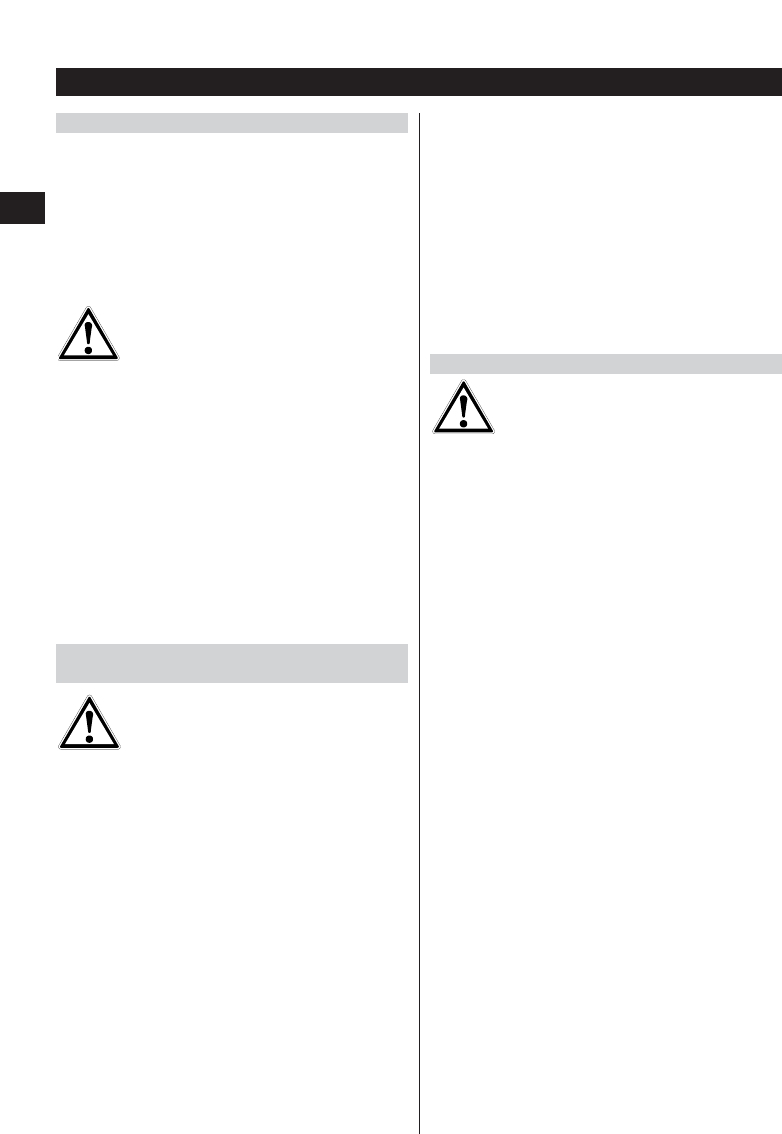
16
en
5. Safety precautions
5.1 Basic information concerning safety
In addition to the information relevant to safety given
in each of the sections of these operating instructions,
the following points must be strictly observed at all
times.
-ATTENTION-
Read all safety precautions and instructions! Failure to
observe the following safety precautions and instruc-
tions may lead to electric shock, fire and/or serious
injury.
● Observe the information given in the operating instruc-
tions concerning operation, care and maintenance.
● Nevertheless, the tool and its accessories may present
hazards when used incorrectly by untrained person-
nel or when misused.
● Do not make use of incorrect accessories (e.g. the
wrong circular saw blade, the wrong extraction con-
nector or the wrong type of vacuum cleaner).
● To avoid the risk of injury, always use only Hilti origi-
nal accessories.
● Connect the tool to an external dust removal system
if the material to be cut produces dust hazardous to
health.
● Modification of the tool is not permissible.
● Do not use the tool for cutting tree branches or logs.
5.2 Take the necessary precautions to make the
workplace safe
● Ensure that the workplace is well lit.
● Ensure that the workplace is well ventilated.
● Keep the working area tidy. Objects which could cause
injury should be removed from the working area. Untidi-
ness at the workplace may lead to accidents.
● Keep the area above and below the cutting line free of
obstacles.
● Secure the workpiece. Use clamps or a vice to hold
the workpiece securely in position. It is then held more
safely and both hands remain free for holding and
operating the tool.
● Wear protective goggles. Wear breathing protection
if the work creates dust.
● Wear suitable working clothing. Do not wear loose
clothing, loose long hair or jewelry as these can become
caught up in moving parts. Wear a hair net if you have
long hair.
● When working, keep other persons, particularly children,
outside the range of the tool. Do not permit other per-
sons to touch the electric tool or the extension cord.
● Avoid unusual body positions. Work from a secure
stance and stay in balance at all times.
● Connect the dust removal system. Ensure that it is
connected and used correctly.
● To avoid tripping and falling when working, always lead
the supply cord, extension cord and extraction hose
away to the rear.
● Concealed electric cables or gas and water pipes pre-
sent a serious hazard if damaged while you are work-
ing. Accordingly, check the area in which you are work-
ing beforehand (e.g. using a metal detector). Avoid
contact between your body and earthed / grounded
objects, such as pipes or radiators. External metal parts
of the tool may become live, for example, when an elec-
tric cable is damaged inadvertently.
5.3 General safety precautions
● Use the right electric tool for the job. Do not use the
tool for purposes for which it was not intended. Use
the tool only as directed and when it is in faultless
condition.
● Use only the original accessories and auxiliary equip-
ment listed in the operating instructions. Use of acces-
sories or items of auxiliary equipment other than those
listed in the operating instructions may present a risk
of personal injury.
● Take the influences of your surroundings into account.
Do not expose the tool to rain or snow and do not use
it in damp or wet conditions. Do not use the tool where
there is a risk of fire or explosion.
● Keep the tool, especially its grip surfaces, clean and
free from oil and grease.
● Do not overload the tool. It will operate more efficiently
and more safely within the performance range for
which it was designed.
● Always hold the tool securely, with both hands on the
grips provided.
● Switch on the tool only after it has been brought into
position where the cut is to be made.
● The dust removal hood should not be disassembled.
● Store tools in a safe place when not in use. When not
in use, tools should be stored in a dry, high place or
locked away where they are out of reach of children.
● Avoid unintentional starting. Do not carry the tool with
your finger on the on/off switch. Check that the on /
off switch is in the “off” position before plugging the
supply cord into the electric socket.
● Disconnect the supply cord plug from the socket when
the tool is not in use (e.g. during breaks, before main-
tenance and before changing insert tools).
● Switch the tool off before transporting it.
● Take care of your insert tools. You will be able to work
more efficiently and more safely if the insert tools are
kept sharp and clean. Observe instructions on care and
maintenance and on changing insert tools.


















